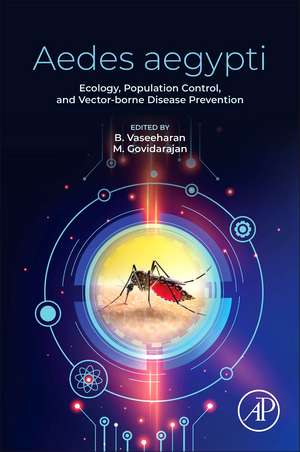Aedes aegypti: Ecology, Population Control, and Vector-borne Disease Prevention
Editat de B. Vaseeharan, M. Govindarajanen Limba Engleză Paperback – iul 2025
Professors, researchers, and students at and above the graduate level in the fields of entomology, parasitology, virology, and epidemiology will gain insights into recent developments in the control of Aedes aegypti and the illnesses it spreads. Companies and industry professionals working on new technologies aimed at this purpose can use this work to review current research and technologies in order to build upon it in their work.
- Covers the aedes aegypti mosquito, including its life cycle, biology, and competence as a vector for diseases such as zika virus and dengue fever
- Outlines strategies population control to prevent vector-borne illness, as well as potential challenges in control methods
- Offers the latest, state-of-the-art information to entomologists, ecologists, and biologists working at research facilities and government agencies
Preț: 815.72 lei
Preț vechi: 896.40 lei
-9% Nou
Puncte Express: 1224
Preț estimativ în valută:
156.11€ • 162.77$ • 129.74£
156.11€ • 162.77$ • 129.74£
Carte nepublicată încă
Doresc să fiu notificat când acest titlu va fi disponibil:
Se trimite...
Preluare comenzi: 021 569.72.76
Specificații
ISBN-13: 9780443214615
ISBN-10: 0443214611
Pagini: 225
Dimensiuni: 152 x 229 mm
Editura: ELSEVIER SCIENCE
ISBN-10: 0443214611
Pagini: 225
Dimensiuni: 152 x 229 mm
Editura: ELSEVIER SCIENCE
Cuprins
I. An Introduction to Mosquitos: Aedes aegypti
1. Epidemiological impact of Aedes aegypti
2. Behavior and Ecology of Aedes mosquitos
3. Microbiota and vector competence of Aedes mosquitos
II. Aedes aegypti: Mechanisms of Action in Vector-borne diseases
4. Dengue Virus and Aedes aegypti
5. Yellow Fever Virus and Aedes aegypti
6. Chikungunya, Zika virus and Aedes aegypti
III. Control Measures of Aedes aegypti
7. Chemical interventions and approaches and non-chemical larviciding: species of larvivorous fish used
8. Habitat Management: Existing endemicity
9. Microbial Secondary Metabolites in the Control of Aedes aegypti
IV. Advanced Control Strategies
10. Nano drug delivery approaches in the control of Aedes aegypti
11. Electrochemical biosensing for mosquito control
12. Machine learning techniques in the control of Aedes aegypti
V. Challenges in mosquito control
13. Development of Insecticide-resistant mosquitos and impact of environmental changes on ecological traits of mosquitos
14. Lack of insights into mosquito dispersal and mating behavior
15. Future Directions of Research and Surveillance for the Control of Aedes aegypti
1. Epidemiological impact of Aedes aegypti
2. Behavior and Ecology of Aedes mosquitos
3. Microbiota and vector competence of Aedes mosquitos
II. Aedes aegypti: Mechanisms of Action in Vector-borne diseases
4. Dengue Virus and Aedes aegypti
5. Yellow Fever Virus and Aedes aegypti
6. Chikungunya, Zika virus and Aedes aegypti
III. Control Measures of Aedes aegypti
7. Chemical interventions and approaches and non-chemical larviciding: species of larvivorous fish used
8. Habitat Management: Existing endemicity
9. Microbial Secondary Metabolites in the Control of Aedes aegypti
IV. Advanced Control Strategies
10. Nano drug delivery approaches in the control of Aedes aegypti
11. Electrochemical biosensing for mosquito control
12. Machine learning techniques in the control of Aedes aegypti
V. Challenges in mosquito control
13. Development of Insecticide-resistant mosquitos and impact of environmental changes on ecological traits of mosquitos
14. Lack of insights into mosquito dispersal and mating behavior
15. Future Directions of Research and Surveillance for the Control of Aedes aegypti
